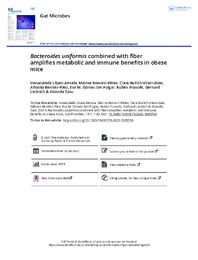Please use this identifier to cite or link to this item:
https://hdl.handle.net/11000/31333
Bacteroides uniformis combined with fiber amplifies metabolic and immune benefits in obese mice
Title:
Bacteroides uniformis combined with fiber amplifies metabolic and immune benefits in obese mice |
Authors:
López Almela, Inmaculada 
Romaní Pérez, Marina 
Bullich-Vilarrubias, Clara 
Benítez-Páez, Alfonso 
Gómez Del Pulgar, Eva M.
Francés, Rubén 
Liebisch, Gerhard 
Sanz, Yolanda |
Department:
Departamentos de la UMH::Medicina Clínica |
Issue Date:
2021-12 |
URI:
https://hdl.handle.net/11000/31333 |
Abstract:
Gut microbiota represents a therapeutic target for obesity. We hypothesize that B. uniformis CECT 7771 combined with wheat bran extract (WBE), its preferred carbon source, may exert superior anti-obesity effects. We performed a 17-week intervention in diet-induced obese mice receiving either B. uniformis, WBE, or their combination to identify interactions and independent actions on metabolism and immunity. B. uniformis combined with WBE was the most effective intervention, curbing weight gain and adiposity, while exerting more modest effects separately. The combination restored insulin-dependent metabolic routes in fat and liver, although the bacterium was the primary driver for improving whole-body glucose disposal. Moreover, B. uniformis-combined with WBE caused the highest increases in butyrate and restored the proportion of induced intraepithelial lymphocytes and type-3 innate lymphoid cells in the intestinal epithelium. Thus, strengthening the first line of immune defense against unhealthy diets and associated dysbiosis in the intestine. This intervention also attenuated the altered IL22 signaling and liver inflammation. Our study shows opportunities for employing B. uniformis, combined with WBE, to aid in the treatment of obesity.
|
Keywords/Subjects:
Obesity
dietary fiber
microbiota
intraepithelial lymphocytes
innate lymphoid cells |
Type of document:
application/pdf |
Access rights:
info:eu-repo/semantics/openAccess
Attribution-NonCommercial-NoDerivatives 4.0 Internacional |
DOI:
https://doi.org/10.1080/19490976.2020.1865706 |
Appears in Collections:
Artículos Medicina Clínica
|
 ???jsp.display-item.text9???
???jsp.display-item.text9???

.png)
